Es war ein packendes 106. Stadtderby, welches der FC St. Pauli mit 3:2 gewann. Verdient hat er sich das vor allem mit einer überragenden ersten und einer abgekochten zweiten Halbzeit. Der Hamburger SV hingegen zeigte ansehnliches Positionsspiel, schien damit aber eher sich als den Gegner verwirrt zu haben und blieb trotz viel Ballbesitz ineffektiv. In der Analyse schauen wir uns die Konzepte und deren Auswirkungen etwas genauer an.
(Titelbild: Peter Böhmer)
Die Aufstellung
Vor dem Spiel stellte sich für mich die Frage nach der Besetzung der Position neben Guido Burgstaller. Letztlich stand Simon Makienok neben Burgstaller in der Startelf. Ob er das auch getan hätte, wenn Maximilian Dittgen einsatzbereit gewesen wäre? Diese Frage stellt sich nicht, denn wir werden es wohl nicht erfahren. Und im Nachhinein ist die Entscheidung goldrichtig gewesen und ich habe Simon freudetrunken meine Liebe gestanden (auf diesem Wege sende ich Maximilian Dittgen und seiner Familie herzliche Glückwünsche zur Geburt seiner zweiten Tochter!).
Neben der Frage, wer im Angriff spielen wird, hatte ich im Vorbericht auch überlegt, ob der FC St. Pauli auf das hohe Tempo des HSV reagieren wird und dort bereits angemerkt, dass es für Rico Benatelli eng werden könnte mit einem Startelfeinsatz. Marcel Hartel kam direkt wenige Tage nach seiner Verpflichtung zu seinem Startelf-Debüt und ersetzte Rico Benatelli auf der halblinken Rautenposition.
Der Hamburger SV veränderte seine Startelf auf zwei Positionen im Vergleich zum erfolgreichen, aber eher wenig überzeugenden 2:1-Erfolg in der ersten Pokalrunde in Braunschweig: Bakery Jatta ersetzte Manuel Wintzheimer in der Offensive und, wie erwartet, ersetzte der wieder genesene Jonas Meffert auf der Sechser-Position Maximilian Rohr. Im Vergleich zum Braunschweig-Spiel änderte sich zu Spielbeginn auch die Formation wenig: Sonny Kittel rückte von der Zehner- auf die Außenposition, sodass sich anstelle eines 4-4-2 mit Raute ein 4-3-3 ergab (was aber angesichts der massiven Positionsrochaden eher nur eine ganz grobe Orientierung gibt).

Spielaufbau HSV – Alles für Jatta?
Eine Rückmeldung zu meiner Tätigkeit am AFM-Radio-Mikro während des Spiels: „Warum sagst Du ständig ’schön‘, wenn der HSV den Ball hat?“ – Uppsi. Aber mal ehrlich, was der HSV in den eigenen hinteren Reihen an Flexibilität zeigte, fand ich ziemlich beeindruckend. Sowas habe ich ehrlich gesagt noch nie gesehen. Im Spielaufbau ordnete sich der HSV zwar in einer Viererkette hinten an, aber wer da genau in der Viererkette wann und wo zu finden war, gestaltete sich komplett flexibel. Besonders Jan Gyamerah und Sebastian Schonlau verließen ihre Positionen immer und immer wieder, der junge Jonas David tat das etwas gedämpfter. Ludovit Reis und teils sogar Sonny Kittel wechselten sich ständig mit Tim Leibold auf der Linksverteidiger-Position ab. Meine Güte, da war was los!
Mit dieser enormen Rotation schaffte es der HSV ziemlich ansehnlich immer wieder Dreiecke zu bilden. Allerdings waren diese zumeist auf für den FCSP ungefährliche Zonen beschränkt. Ein bisschen Ordnung in diesem Chaos gab es aber doch: Denn während der HSV auf links fröhlich rotierte, war Kinsombi auf rechts immer eher in die Spitze unterwegs (oder versuchte eine vertikale Verbindung ganz außen für Jatta zu basteln) und Gyamerah verließ seine Position fast immer gen Zentrale. Das Ziel: Raum für Bakery Jatta schaffen, indem das Spiel nahezu komplett auf die linke Seite verlagert wurde, um ihn mit einem Diagonalpass zu finden. In der ersten Halbzeit waren diese tiefen Läufe von Jatta tatsächlich die einzig gefährlichen Aktionen des HSV. Sie waren auch deshalb selten, da Leart Paqarada zeigte, das er nicht nur offensiv einiges entwickeln kann, sondern auch einfach ein brutal guter Verteidiger ist (10 abgefangene Pässe, 8 von 10 Zweikämpfen gewonnen). Nur Jatta freispielen ist natürlich nicht der Plan gewesen. Aber die ganzen Rotationen, die ja nicht risikolos sind, wie der FCSP schonungslos aufgezeigt hat, das ganze BimBamBorium, es sorgte nur dafür, dass Jatta in der ersten Halbzeit dreimal (ich habe extra nochmal gezählt im Re-Live) mit Ball bis auf die Grundlinie durchbrechen konnte. Ansonsten sorgten die Positionsrochaden des HSV für Chaos. Aber nicht beim FC St. Pauli, sondern in den eigenen Reihen.
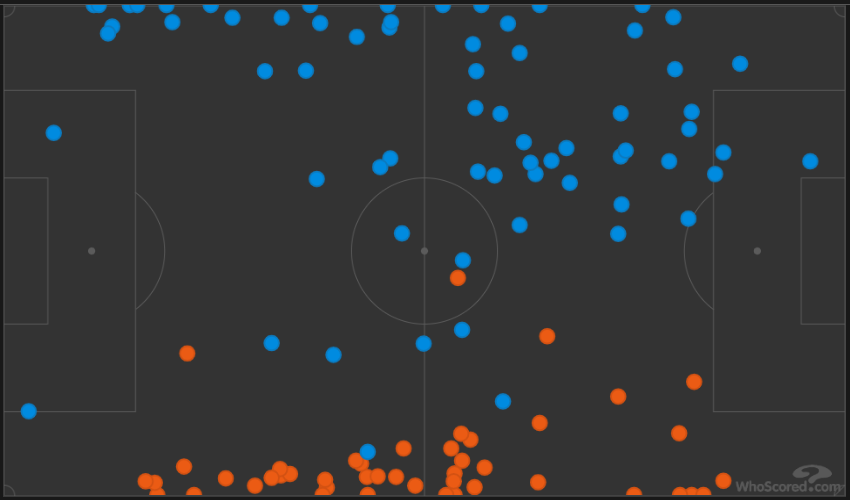
Quelle: whoscored.com
Pressing FC St. Pauli – Mutig und im Raum
Zwischenzeitlich führte das Auflösen der Position in der Hintermannschaft des HSV (vornehmlich nach eigenen Pässen, denen die Spieler, ich kann es nicht anders ausdrücken, „nachliefen“) dazu, dass die Stürmer des FCSP dem HSV-Tor näher waren als alle HSV-Spieler. Denn der FCSP nahm das Auflösen der Positionen zwar zur Kenntnis und wirkte davon nicht überrascht, aber Makienok und Burgstaller blieben einfach im Raum stehen und gingen die Wege der HSV-Innenverteidiger nicht mit. Eine richtige Absicherung war im Spiel des HSV nicht vorhanden, sodass ein Fehlpass in einer solchen Situation todsicher zu Hallihallo-Lichterloh-Momenten im HSV-Strafraum geführt hätte. Was für ein Spiel mit dem Feuer vom HSV! Es grenzt an ein Wunder, dass der FC St. Pauli das so direkt nicht ein einziges Mal bestrafen konnte (sie bestraften dafür andere chaotische Zustände). Ich schreibe das explizit aus, da diese Art des Positionsspiels eines der radikalsten Elemente des Walter-Fußballs ist und ich davon ausgehe, dass genau dieses Element gegen smarte Teams für Genickbrüche sorgen wird. Die enorme spielerische Qualität von z.B. Schonlau sorgt dafür, dass es meist gut geht, aber das wird es sicher nicht über die gesamte Saison.
Der FC St. Pauli konzentrierte sich im Pressing also mit seinen beiden Stürmern auf die beiden Innenverteidiger. Jonas Meffert dürfte sich mit einigem Grausen an seinen letzten Auftritt am Millerntor erinnert haben. Denn der Sechser des HSV war der einzige Spieler auf dem Platz, der fast das gesamte Spiel in Manndeckung genommen wurde. Und zwar von Daniel-Kofi Kyereh.
Die beiden Achter, Hartel und Becker, liefen die gegnerischen Außenverteidiger bzw. die Spieler, die dort gerade in der Position waren, an, wenn diese den Ball erhielten. Das ist eine Erwähnung wert, da es sich hierbei um eine Abkehr vom Pressingverhalten aus dem letzten Spiel in Magdeburg handelte, wieder hin zu dem vorher praktiziertem Prinzip. Spielte der HSV im Aufbau in die Halbräume, so war es Eric Smith, der dort attackierte und damit als eine Art Absicherung für die beiden Achter im Pressing diente. Das konnte er, da er zentral in der Defensive ohne Auftrag bzw. Gegenspieler unterwegs war.
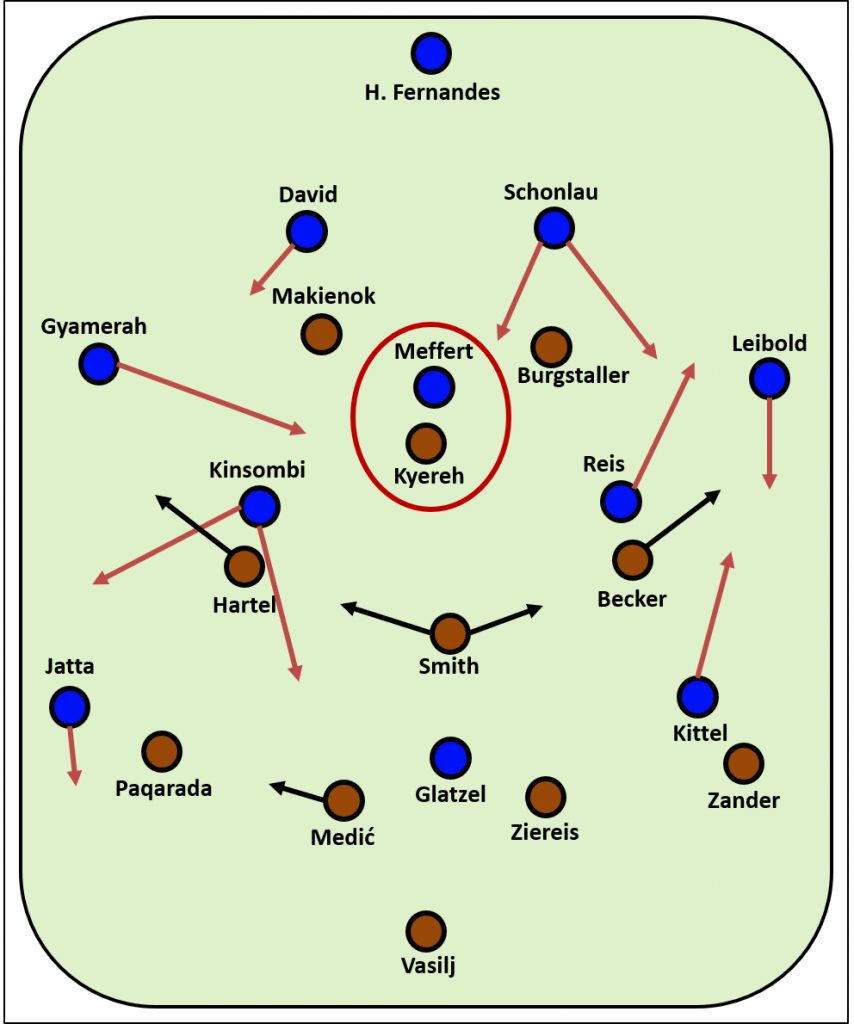
Warum klappte der Aufbau des HSV nicht?
Das ist die spielentscheidende Frage. Denn durch das Auflösen der Einzelpositionen und die Positionierung der FCSP-Spieler im Raum, hat der HSV eigentlich alle Kriterien erfüllt, um Überzahlsituationen in einigen Zonen auf dem Platz zu erschaffen. Aber der FC St. Pauli besetzte die Räume eben sehr gut und konnte immer dann, wenn es wichtig wurde, die Überzahl des HSV verhindern. Auf der anderen Seite wirkte es so, als wenn der HSV schlicht die Übersicht verlor und aufgrund der vielen unterschiedlichen Bewegungen die teils überladenden Räume gar nicht als solche erkannte. So war das Positionsspiel des HSV schön anzusehen, aber vor allem ineffektiv. Wie so’n Kriegstanz von ’ner Luftpumpe: Im sicheren Hafen wird sich ganz dick aufgeplustert und dann, wenn es wirklich ernst wird, entweicht die ganze Luft mit dem leisen Ton eines unterwürfigen Hundes.
Der FC St. Pauli hingegen agierte sehr viel strukturierter und zielstrebiger bei eigenem Ballbesitz: Sobald der Ball im Spielaufbau den eigenen Außenverteidiger erreichte, ließ sich zumeist Kyereh aus dem Sturmzentrum auf die Zehnerposition fallen (manchmal mit, meist ohne Burgstaller, der sich eher in Richtung Außenbahn orientierte). Genau in diesen Raum, der aufgrund der Positionierung des HSV-Pressings etwas verwaist war, spielten die Außenverteidiger häufig die Bälle diagonal rein. Luca Zander spielte allein in der ersten Halbzeit siebenmal einen solchen Pass auf Kyereh (dies war damit hinter Ziereis auf Zander der häufigste Passweg beim FCSP). Nur der allererste kam nicht an.
Das war eine simple, aber ziemlich effektive Eröffnung, da das Pressing des HSV so konsequent umspielt wurde und der FCSP trotzdem meist im Ballbesitz blieb. In der Folge rückten die beiden Achter nach. Marcel Hartel, der sich trotz wenig Team-Training bemerkenswert gut ins Spiel einbringen konnte, blieb eher im Halbraum für 2.Bälle (übrigens hat er in diesem Spiel für einen Achter absolut überragende neun Pässe abgefangen und gewann sieben von zehn Defensiv-Zweikämpfen). Wenn Burgstaller auf die Außenbahn auswich, dann rückte Becker bis ins Sturmzentrum vor.
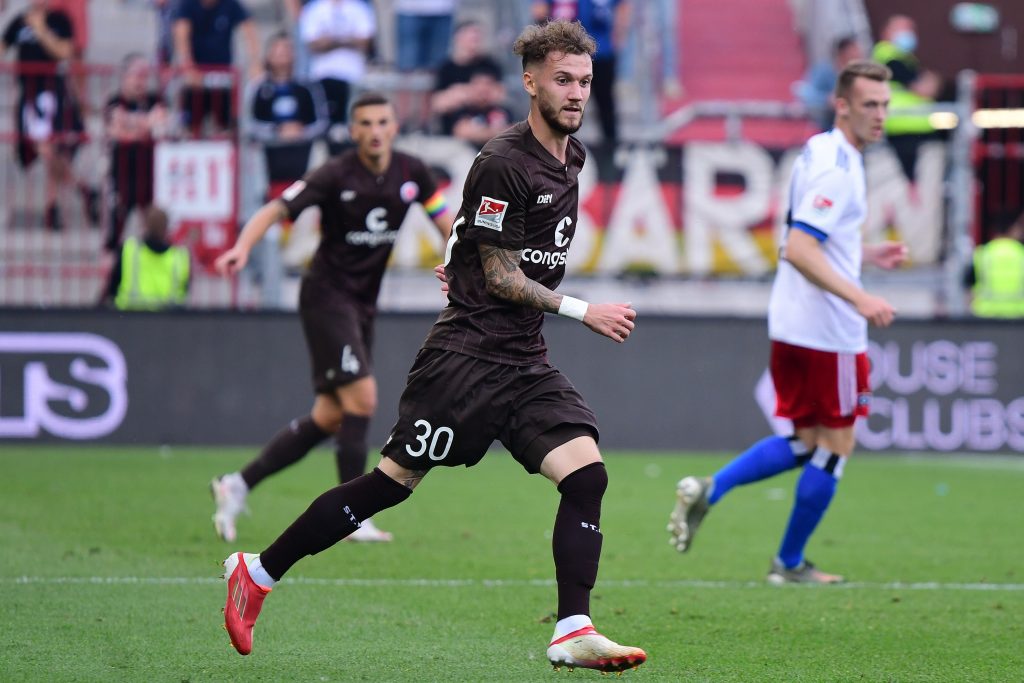
(c) Peter Böhmer
Die gute Raumaufteilung des FC St. Pauli sorgte dann, zusammen mit der schlechten Raumaufteilung des HSV in defensiven Umschaltmomenten für viele gefährliche Situationen in der 1.Halbzeit. Beispielhaft ist da das erste Tor für den FCSP: Es war Jan Gyamerah, der die wohl entscheidende Rolle spielte. Erst wurde ein falscher Einwurf von ihm zurecht abgepfiffen (hätte bei seinen vorherigen Einwürfen auch schon passieren dürfen), der HSV konnte den Ball zurückerobern, Gyamerah löste im Aufbau seine Position auf, der HSV verlor den Ball, Ziereis spielte einen schnellen Pass genau in den Raum hinten rechts, wo Gyamerah eigentlich bei Ballbesitz FCSP sein sollte, Burgstaller und Hartel Kyereh spielten die Überzahl gekonnt aus, Becker rückte ein – BÄM!
Diese Führung war zu dem Zeitpunkt hochverdient. Denn der HSV brachte in der 1.Halbzeit bis zum Ausgleich bis auf eine Chance nach Durchbruch und Querpass von Jatta (die Kinsombi sauber vor dem einschussbereiten Glatzel klärte…) keine nennenswerte Offensivaktion zustande. Der FC St. Pauli hingegen wusste die Räume vor allem in Umschaltmomenten für sich zu nutzen, brachte es auf elf Torschüsse bis zur Halbzeit (HSV: zwei). Besonders die Phase zwischen der 16. und 30. Minute war herausragend. Vor allem deswegen, weil der FCSP viele Bälle im letzten Drittel des HSV gewann: Ganze acht von insgesamt 19 Ballverlusten im eigenen Drittel passierten dem HSV in diesem Spielabschnitt. Der FC St. Pauli verlor in dieser Phase defensiv überhaupt nur drei Duelle, nur ein einziges Mal den Ball im eigenen letzten Drittel und brachte alle(!) 25 raumbringenden Pässe zum Mitspieler.
Doch trotz dieser ziemlich rauschhaften ersten Halbzeit ging der FC St. Pauli mit einem Remis in die Halbzeitpause. Weil Meffert einmal nicht von Kettenhund Kyereh eng genug bewacht wurde, konnte der HSV zentral die Kette überspielen und auf rechts Jatta tief schicken. Das 1:1 war aus Sicht des HSV sehr schmeichelhaft.
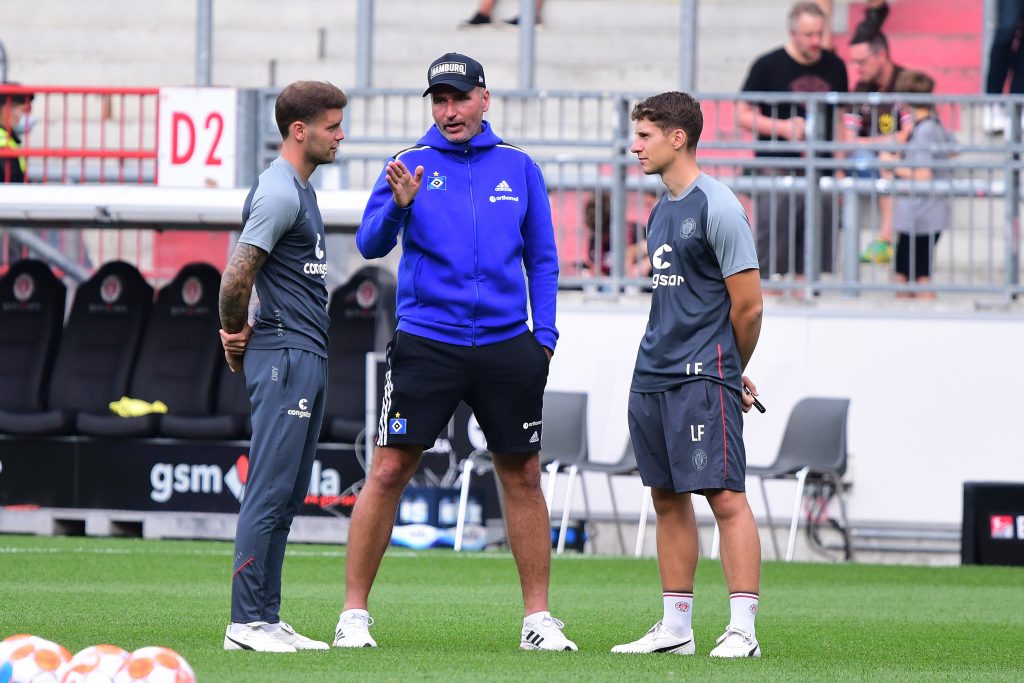
(c) Peter Böhmer
Mehr Druck, aber wo ist Gyamerah?
Nach der Halbzeitpause stellte der HSV seine Formation leicht um: Sonny Kittel agierte nun aus zentraler Position und auch Ludovit Reis war nun mehr auf der Halbposition zu finden und nicht mehr hinten links im Aufbau. Das sorgte zusammen mit dem nun etwas weniger griffigen Pressing des FCSP für deutlich mehr Druck vom HSV. Auch deshalb, da Eric Smith nun deutlich mehr Arbeit im Zentrum zu erledigen hatte. Gleich direkt nach Wiederanpfiff war es eine Flanke von der linken Grundlinie (von Rechtsverteidiger(!) Gyamerah), die erste Gefahr brachte. Und ja, sorry, aber ich sehe da auch einen Kontakt zwischen Medić und Jatta, der zum Elfmeter hätte führen müssen.
Aber gerade in der vermeintlich stärksten Phase des HSV legte der FC St. Pauli dessen Schwächen unter das Brennglas: Beim 2:1 wich Makienok auf die linke Seite aus, wo Gyamerah fehlte, sodass Makienok ohne Gegnerdruck fast bis ans Fünfereck andribblen konnte (was Innenverteidiger David sicher auch nicht so geplant hatte). Das Tor dürfte zu großen Teilen Torwart Heuer Fernandes angelastet werden. Dessen Stammplatz ist ja so oder so gefährdet, in Marko Johansson wurde kürzlich ein neuer Torwart verpflichtet.
Wie dem auch sei, nur kurze Zeit nach der erneuten Führung gewinnt Jakov Medić erst stark den Ball, spaziert dann ohne Druck durch die HSV-Hälfte und spielt dann einen Pass zu Makienok. Der hatte sich leicht nach links abgesetzt, da es dort Raum gab, weil ein gewisser Jan Gyamerah mal wieder auf Abwegen war. 3:1 für den FC St. Pauli!
Alle drei Tore fallen, weil Teile der HSV-Verteidigung nicht dort waren, wo sie hingehörten. Die ansehnlichen Positionsrochaden, die den FC St. Pauli verwirren sollten, die für Übergewicht in bestimmten Zonen sorgen sollten – sie sorgten letztlich dafür, dass der FCSP diese drei Tore erzielen konnte. Das klingt fatal schlecht vom HSV und das ist es auch, wenngleich der FCSP es auch einfach richtig gut ausgespielt hat.

(c) Peter Böhmer
Das Spiel bekam durch das 3:1 einen doch recht klaren Bruch und gönnte sich eine Auszeit. Die Vorteile der Spielanlage des HSV sorgten dann doch noch dafür, dass es zum Ende nochmal spannend wurde. Denn es war Innenverteidiger Sebastian Schonlau, der von der linken Grundlinie ins Zentrum flankte, wo Robert Glatzel den Ball sehenswert verarbeitete und im FCSP-Tor unterbrachte. Mit Suhonen wurde auch noch einmal mächtig Kreativität eingewechselt, während der FC St. Pauli den angeschlangenen Smith ersetzen musste und im Angriff nicht den nötigen Konterspieler bringen konnte, weil im Kader überhaupt kein Stürmer mehr war.
In der Folge zeigte sich aber auch, dass der FC St. Pauli eine Führung auch verteidigen kann. Vor weniger als einem Jahr war ein gegnerischer Anschlusstreffer bereits das Todesurteil für mögliche drei Punkte. Egal wie gut und überlegen der FCSP vorher spielte, die Beine wurden sofort zu Wackelpudding. Diese Zeiten scheinen vorüber, wenn man sich die Minuten bis zum Abpfiff bei diesem Derby anschaut.
Der FC St. Pauli gewinnt also erneut die Stadtmeisterschaft. Dank einer enormen Laufbereitschaft, einer guten Raumaufteilung und dem Vertrauen in die eigenen Fähigkeiten und das eigene System. Dieses Spiel hat nicht nur Derby-Geschichte geschrieben, es macht auch Lust auf mehr von diesem Team. Der Saisonstart ist mit drei Siegen aus vier Spielen definitiv geglückt. Die Stabilität in schwierigen Phasen ist beeindruckend. Die offensive Power auch. Es macht großen Spaß die Entwicklung der Mannschaft zu verfolgen und ich freue mich wahnsinnig auf den Rest der Saison.
Forza!
//Tim
Alle Beiträge beim MillernTon sind gratis. Wir freuen uns aber sehr, wenn Du uns unterstützt.
MillernTon auf BlueSky // Mastodon // Facebook // Instagram // Threads // WhatsApp // YouTube
{:}{:en}It was a thrilling 106th city derby, which FC St. Pauli won 3:2. It was deserved, above all, with an outstanding first half and a cooked-up second half. Hamburger SV, on the other hand, showed respectable positional play, but seemed to have confused themselves rather than their opponents and remained ineffective despite having a lot of possession. In the analysis, we take a closer look at the concepts and their effects.
(Cover picture: Peter Böhmer)
The line-up
Before the game, I wondered who would play next to Guido Burgstaller. In the end, Simon Makienok was in the starting eleven next to Burgstaller. Would he have done the same if Maximilian Dittgen had been available? That’s not the question, because we probably won’t know. And in retrospect, the decision was spot on and I confessed my love to Simon drunk with joy (in this way I send Maximilian Dittgen and his family my heartfelt congratulations on the birth of their second daughter!).
In addition to the question of who would play in attack, I had also considered in the preliminary report whether FC St. Pauli would react to HSV’s high tempo and had already noted there that it could be tight for Rico Benatelli with a starting eleven. Marcel Hartel made his debut in the starting eleven just a few days after his signing and replaced Rico Benatelli on the left half of the diamond.
Hamburger SV changed their starting eleven in two positions compared to the successful but rather unconvincing 2-1 victory in the first cup round in Braunschweig: Bakery Jatta replaced Manuel Wintzheimer in the attack and, as expected, the recovered Jonas Meffert replaced Maximilian Rohr in the six-position. Compared to the Braunschweig game, the formation changed little at the start of the game: Sonny Kittel moved from the ten to the outside position, resulting in a 4-3-3 instead of a 4-4-2 with a diamond (which, however, only gives a very rough orientation in view of the massive positional changes).

Build-up play of the HSV – All for Jatta?
Feedback on my activity at the AFM radio mike during the match: „Why do you keep saying ‚beautiful‘ when HSV has the ball?“ – Oops. But let’s be honest, what HSV showed in terms of flexibility in their own back rows I thought was pretty impressive. To be honest, I’ve never seen anything like it. In the build-up to the game, HSV arranged themselves in a back four, but who exactly was to be found where and when in the back four was completely flexible. Especially Jan Gyamerah and Sebastian Schonlau left their positions over and over again, young Jonas David did it more subdued. Ludovit Reis and sometimes even Sonny Kittel constantly alternated with Tim Leibold on the left-back position. My goodness, there was something going on!
With this enormous rotation, HSV managed to form quite respectable triangles again and again. However, these were mostly limited to zones that were not dangerous for FCSP. There was a bit of order in this chaos, though: While HSV happily rotated on the left, Kinsombi on the right was always more towards the top (or tried to create a vertical connection on the far outside for Jatta) and Gyamerah almost always left his position towards the centre. The aim: to create space for Bakery Jatta by shifting the play almost completely to the left to find him with a diagonal pass. In the first half, these deep runs by Jatta were in fact HSV’s only dangerous actions. They were also rare because Leart Paqarada showed that he can not only develop a lot offensively but is also simply a brutally good defender (10 intercepted passes, 8 out of 10 duels won). Just releasing Jatta was not the plan, of course. But all the rotations, which are not without risk, as FCSP has relentlessly shown the whole chaos, it only ensured that Jatta could break through to the baseline with the ball three times in the first half (I counted it again in the re-live). Apart from that, HSV’s positional chaos was the order of the day. But not for FC St. Pauli, but in their own ranks.

Source: whoscored.com
Pressing FC St. Pauli – Courageous and in space
In the meantime, the breaking up of positions in the HSV back line (mainly after their own passes, which the players, I can’t put it any other way, „ran after“) meant that the FCSP strikers were closer to the HSV goal than all the HSV players. For FCSP took note of the breaking up of positions and did not seem surprised by it, but Makienok and Burgstaller simply stayed in space and did not follow the paths of the HSV centre-backs. There was no proper protection in HSV’s play, so that a misplaced pass in such a situation would have led to sure-fire moments in the HSV penalty area. What a game of fire from HSV! It borders on a miracle that FC St. Pauli could not punish this so directly even once (they punished other chaotic conditions for it). I write this out explicitly because this kind of positional play is one of the most radical elements of Walter football and I assume that it is precisely this element that will cause neck-breaks against smart teams. The enormous playing quality of e.g. Schonlau ensures that it usually goes well, but it certainly won’t over the whole season.
FC St. Pauli thus concentrated their pressing on the two centre-backs with their two strikers. Jonas Meffert must have remembered his last appearance at the Millerntor with some horror. The HSV six was the only player on the pitch who was marked man-to-man for almost the entire match. And that was by Daniel-Kofi Kyereh.
The two eights, Hartel and Becker, ran at the opposing full-backs or the players who were currently in position there when they received the ball. This is worth mentioning as it was a departure from the pressing behaviour of the last game in Magdeburg, back to the principle practised before. If HSV played into the half-https://millernton.de/2021/08/09/1-fc-magdeburg-fc-st-pauli-23-rautendaemmerung/areas in the build-up, it was Eric Smith who attacked there and thus served as a kind of protection for the two eights in the pressing. He was able to do this because he was in the centre of the defence without a mission or opponent.

Why didn’t the HSV build-up work?
That is the game-changing question. Because by breaking up the individual positions and positioning the FCSP players in space, HSV actually fulfilled all the criteria to create outnumbering situations in some zones on the pitch. But FC St. Pauli occupied the spaces very well and was always able to prevent HSV from being outnumbered when it became important. On the other hand, it seemed as if HSV simply lost the overview and did not even recognise the sometimes overloaded spaces as such due to the many different movements. Thus, HSV’s positional play was beautiful to watch, but above all ineffective. It was like a war dance of a tyre pump: In the safe harbour they puffed themselves up and then, when things got really serious, all the air escaped with the quiet sound of a submissive dog.
FC St. Pauli, on the other hand, acted much more structured and purposeful in their own possession: As soon as the ball reached their own fullbacks in the build-up to the game, Kyereh mostly dropped from the centre of attack to the ten position (sometimes with, mostly without Burgstaller, who was more oriented towards the outer track). It was precisely into this space, which was somewhat orphaned due to the positioning of the HSV pressing, that the outside defenders often played the balls in diagonally. Luca Zander played such a pass to Kyereh seven times in the first half alone (this was thus the most frequent passing path at FCSP behind Ziereis to Zander). Only the very first one did not arrive.
This was a simple but quite effective opening, as the pressing of HSV was thus consistently bypassed and FCSP nevertheless remained in possession of the ball most of the time. As a result, the two eights moved up. Marcel Hartel, who was able to contribute remarkably well to the game despite little team training, stayed more in the half-space for 2nd balls (by the way, he intercepted an absolutely outstanding nine passes for an eighth in this game and won seven out of ten defensive duels). When Burgstaller moved to the outside, Becker advanced to the centre of the attack.

(c) Peter Böhmer
FC St. Pauli’s good distribution of space, together with HSV’s poor distribution of space in defensive transition moments, led to many dangerous situations in the first half. Exemplary is the first goal for FCSP: It was Jan Gyamerah who played the decisive role. First, a wrong throw-in by him was rightly whistled off (should have happened with his previous throw-ins), HSV was able to win the ball back, Gyamerah broke up his position in the build-up, HSV lost the ball, Ziereis played a quick pass exactly into the space at the right back, where Gyamerah was supposed to be in possession of the ball, Burgstaller and Hartel Kyereh skilfully played out the superior number, Becker moved in – Boom!
This lead was highly deserved at that point. In the first half, HSV had no offensive action worth mentioning except for one chance after Jatta’s break-through and cross pass (which Kinsombi cleared cleanly before Glatzel was ready to shoot…). FC St. Pauli, on the other hand, knew how to use the space to their advantage, especially in transition moments, and had eleven shots on goal by half-time (HSV: two). Especially the phase between the 16th and 30th minute was outstanding. Especially because FCSP won many balls in HSV’s final third: A whole eight of a total of 19 ball losses in their own third happened to HSV in this part of the game. FC St. Pauli lost only three duels defensively in this phase, only once the ball in their own final third and brought all(!) 25 space-bringing passes to their teammates.
But despite this rather raucous first half, FC St. Pauli went into the half-time break with a draw. Because Meffert was once not guarded closely enough by chain dog Kyereh, HSV was able to play centrally over the chain and send Jatta deep on the right. The 1:1 was very flattering from HSV’s point of view.

(c) Peter Böhmer
More pressure, but where is Gyamerah?
After the half-time break, HSV changed their formation slightly: Sonny Kittel now played from a central position and Ludovit Reis was now more to be found in the half position and no longer at left back in the build-up. This, together with FCSP’s now somewhat less gripping pressing, resulted in significantly more pressure from HSV. This was also due to the fact that Eric Smith now had to do more work in the centre. Immediately after the restart, it was a cross from the left baseline (by right-back(!) Gyamerah) that brought the first danger. And yes, sorry, but I also see a contact between Medić and Jatta that should have led to a penalty.
But it was precisely in the supposedly strongest phase of HSV that FC St. Pauli put their weaknesses under the magnifying glass: At 2:1 Makienok moved to the left side, where Gyamerah was missing so that Makienok was able to dribble almost to the five-corner without any pressure from the opponent (which was certainly not planned that way by centre-back David). The goal should be largely blamed on goalkeeper Heuer Fernandes. His regular place is endangered in any case, as a new goalkeeper was recently signed in Marko Johansson.
However, only a short time after regaining the lead, Jakov Medić first won the ball, then walked through the HSV half without pressure and then played a pass to Makienok. Makienok had moved slightly to the left, as there was space there because a certain Jan Gyamerah was once again on the loose. 3:1 for FC St. Pauli!
All three goals came because parts of the HSV defence were not where they belonged. The handsome positional rochades that were supposed to confuse FC St. Pauli, which was supposed to provide superiority in certain zones – they ultimately ensured that FCSP were able to score those three goals. That sounds fatally bad from HSV and it is, although FCSP also just played it really well.

(c) Peter Böhmer
The game was clearly broken up by the 3:1 and took a time-out. The advantages of HSV’s playing system then ensured that the game became exciting again at the end. It was central defender Sebastian Schonlau who crossed from the left baseline into the centre, where Robert Glatzel processed the ball and put it into the FCSP goal. Suhonen was another creative substitute, while FC St. Pauli had to replace the struggling Smith and could not bring in the necessary counterattacking player because there was no striker left in the squad.
As a result, however, it became clear that FC St. Pauli can also defend a lead. Less than a year ago, an opposing goal was already the death knell for a possible three points. No matter how well and superior FCSP played beforehand, their legs immediately became jelly. Those times seem to be over if you look at the minutes until the final whistle in this derby.
So FC St. Pauli wins the town’s championship again. Thanks to an enormous willingness to run, a good division of space and confidence in their own abilities and system. This game not only made derby history, it also makes you want more from this team. The start of the season has definitely been successful with three wins from four games. The stability in difficult phases is impressive. The offensive power as well. It’s great fun to follow the development of the team and I’m really looking forward to the rest of the season.
Forza!
//Tim (translated by Arne)
(Unless otherwise marked, all statistics are from Wyscout)
{:}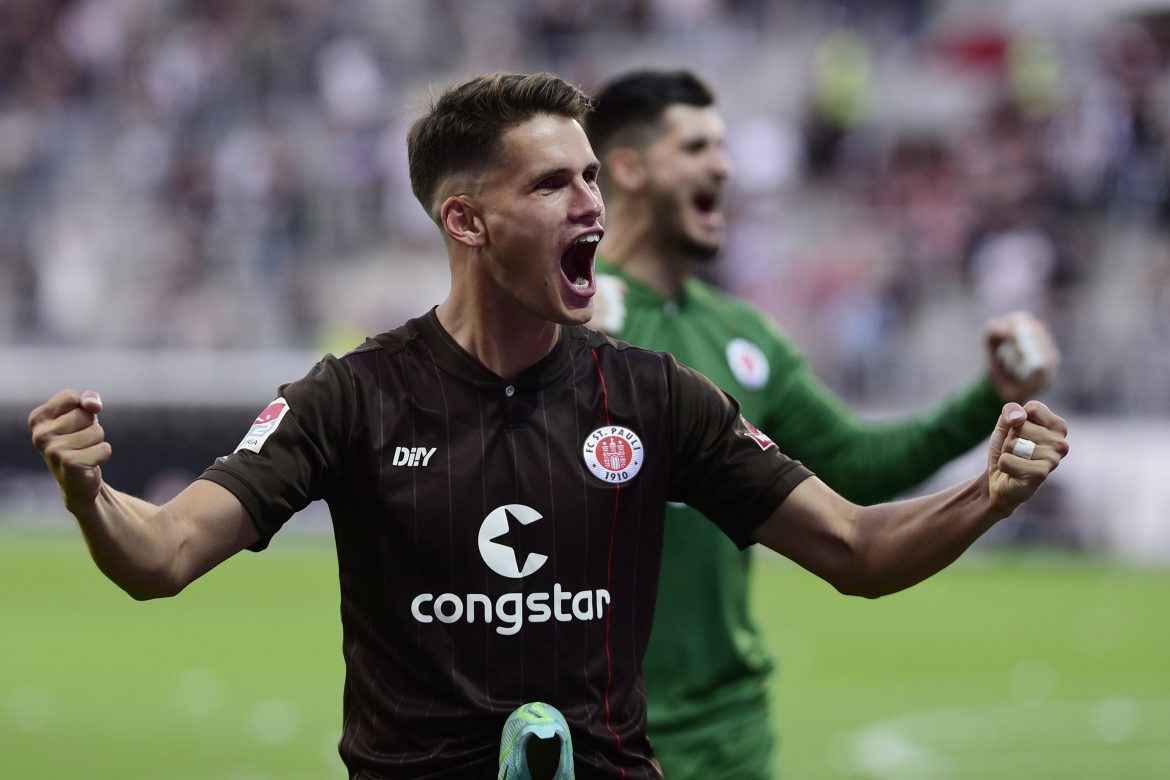

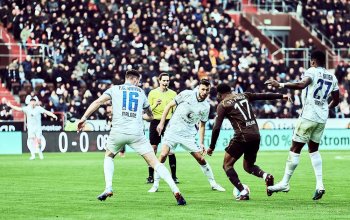
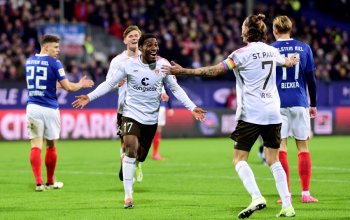
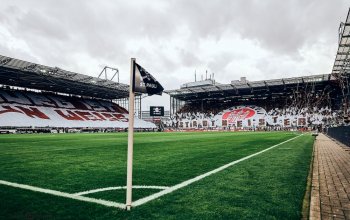
„Wie so’n Kriegstanz von ’ner Luftpumpe: Im sicheren Hafen wird sich ganz dick aufgeplustert und dann, wenn es wirklich ernst wird, entweicht die ganze Luft mit dem leisen Ton eines unterwürfigen Hundes.“
Sehr schöne, bildstarke Formulierung.
Danke Tim.
Ich habe das Winseln immer noch im Ohr 😉
Hah. Die Formulierungen…ein Schmaus so früh am Morgen.
Nach all den System-Analysen und insbesondere dem Youtube-Video des neuen Keepers würde ich das Scouting-System beim HSV als weitere Schwachstelle herausstreichen :)!
Zumindest werden sie nicht mit dem Video gescoutet haben 😉
Danke Tim, schöne Analyse! Unser Doppelschlag kam aber zum richtigen Zeitpunkt. In deren Druckphase wirkten Zander und Becker auf der rechten Seite ganz schön ausgepowert und kamen kaum noch in die Zweikämpfe. Die Unterzahl haben wir nicht so gut aufgefüllt. Nach dem 3:1 war der Druck ja zum Glück erstmal raus.
Ja, es war vielen auf dem Platz anzumerken, dass die erste Halbzeit Körner gekostet hat.
So erlebe ich den Derbysieg gleich nochmal. Danke für die Bereicherung.
Vielen Dank für die gewohnt interessante Analyse!
Eine kritische Anmerkung: Ich fühle mich unwohl bei dem YT link, den du zum neuen HSV-Keeper gepostet hast. Man fragt sich, warum so ein bösartiger Zusammenschnitt von Fails eines jungen Sportlers verbreitet wird. Findest du nicht auch dass das in Richtung „Shitstorm“ geht und dass man sich an der weiteren Verbreitung des links lieber nicht beteiligen sollte?
Mmh, ja, so habe ich das noch gar nicht betrachtet Da gebe ich Dir recht. Ich habe den Link und die entsprechenden Zeilen gelöscht.
Will nicht Afeez runtermachen, denn ich finde, dass er wie das Gesamtteam diese Saison einen weiteren Schritt nach vorne macht, aber: Sowohl gegen den Hasivau als auch eine Woche zuvor beim FCM https://m.youtube.com/watch?v=nJF8hY0Lyck&t=131s sehe ich ihn bei den Gegentoren etwas unglücklich agieren. Beim FCM verliert er vor dem zwischenzeitlichen 2:2 unnötig den Ball am Mittelkreis, gegen den HSV ist er vor dem Anschlusstreffer zum 3:2 von Glatzel beim vorangehenden Einwurf konfus. Er sieht, dass Schonlau frei auf links steht, geht ein paar Schritte in dessen Richtung, besinnt sich dann wohl, dass er eigentlich nicht rechter Verteidiger ist und geht zurück Richtung Mitte. Mmh. Schonlau ist dann jedenfalls komplett unbeaufsichtigt und flankt dann zu Glatzel. Luca Zander, der da gar nicht auf Position war, wurde kurz darauf ausgewechselt. Ist mir halt aufgefallen, dass er gleich zwei Buden hintereinander eingeleitet hat. Da muss er noch etwas klarer werden. Das Gute: Früher hätten uns solche Patzer auf die Verliererstraße gebracht. Jetzt hat der FCSP offenbar genug Qualität, um das wegzustecken und die Spiele dennoch für uns zu entscheiden.
Ja, ich sehe ihn da auch unglücklich agieren. Auf der anderen Seite ist er einer der besten Ballgewinner beim FCSP. Ich bin echt gespannt, wie er sich im Saisonverlauf entwickeln kann.